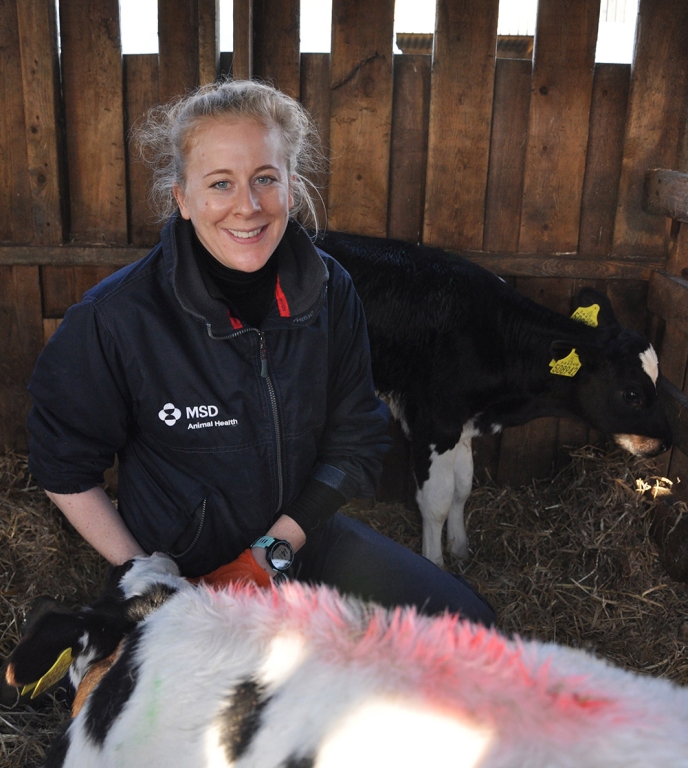
Dr Kat Baxter-Smith from MSD Animal Health said the availability of the new Bovilis Nasalgenâ-C vaccine presents veterinary professionals with another tool in their armoury to help UK cattle farmers improve control of BRD.
New Bovine Coronavirus Vaccine Presents Opportunity To Improve BRD Control On UK Cattle Units
A new bovine coronavirus (BCoV) vaccine from MSD Animal Health UK Limited (a division of Merck & Co., Inc., Rahway, N.J., USA (NYSE: MRK)) offers veterinary professionals the opportunity to help UK cattle farmers improve control of bovine respiratory disease (BRD).
Bovilis Nasalgenâ-C is an intranasal live vaccine that can be used for the active immunisation of calves from the day of birth onwards to reduce clinical signs of upper respiratory tract disease and nasal viral shedding from infection with BCoV.
Speaking at BCVA in Telford, Dr Paul Burr, vet and director of Biobest Laboratories, explained that BCoV is a member of a family of viruses associated with both enteric and respiratory diseases in ruminants.
“BCoV is well-established as a cause of neonatal calf diarrhoea. But furthermore, when present in the respiratory tract, BCoV increases the risk for BRD in calves, resulting in respiratory infections with histopathological lesions and clinical signs,” he said.
Respiratory disease in UK calves is widespread and comes at a high cost from an emotional and business productivity perspective. It’s a classic iceberg disease and one which is continually highlighted as a critical area for overuse of antibiotics. Despite this background, there is an under use of vaccination in the UK cattle sector1.
Dr Burr explained that BCoV is frequently isolated alongside other, more recognised calf respiratory disease pathogens such as BRSV, M. haemolytica, Pi-3 and M. bovis2, suggesting an interplay between these organisms.
“Research has shown that BCoV infection disturbs the protective mucus lining of the thoracic tract3. It may therefore be that BCoV ‘opens the door’ for the other viral and bacterial pathogens to establish themselves and cause disease.”
He stressed that BCoV was highly prevalent in UK cattle. “Recent UK studies show bovine coronavirus being the most prevalent virus found in routine disease screening and nasal swab samples taken during a bovine respiratory disease outbreak. BCoV was found in 39% of over 400 nasal swab samples taken between 2020 and 2022 from BRD affected cattle on UK farms2.”
Dr Baxter-Smith, veterinary adviser with MSD Animal Health, explained that further evidence of BCoV exposure in UK cattle can be found in 2021-2022 BRD screening surveillance data.
“Calf serology conducted by MSD Animal Health on 59 UK farms known to have had a history of BRD issues reported 91.5% of farms being positive for BCoV,” she said.
“Whilst the pathogenicity of BCoV within the BRD complex remains an unknown quantity, its ubiquitous presence in the UK cattle population – and the recent human experience of coronavirus as a significant respiratory pathogen – suggests a need for a re-evaluation of BRD control by vets and farmers.
“Just as coronavirus is a pathogen associated with the common cold and Covid-19, BCoV is a proven pathogen that directly impacts the calf respiratory tract. Consequently, the availability of this new BRD vaccine presents veterinary professionals with another tool in their armoury to improve control of this costly disease.
“If diagnostics suggest BCoV is implicated in any BRD problem, the availability of Bovilis Nasalgenâ-C allows UK cattle farmers to effectively administer protection for young calves via a single 2ml intranasal dose that can quickly reach the site of action. This will support the development of immunity against BCoV early in life, the onset of which starts five days after administration and has a 12-week duration,” she said.
Dr Baxter-Smith also explained that Bovilis Nasalgenâ-C comes with valuable administration flexibility in that it can be used on the same day with Bovilisâ INtranasal RSPÔ Live, which offers protection against both Bovine Respiratory Syncytial Virus (BRSV) and Parainfluenza-3 Virus (Pi3). Bovilis Nasalgenâ-C can be stored for up to 24 hours at room temperature after reconstitution, can be given to cattle using a syringe or applicator device and is available in one, five and 20 dose packs, suitable for both small and large herds.
References:
- MSD Animal Health. Penetration rate calculated October 2017, using Kynetec data and Defra Statistics (2017).
- Nasal swab PCR samples from 407 farmers submitted to Biobest (2020-2022).
- Caswell JL. Failure of respiratory defences in the pathogenesis of bacterial pneumonia of cattle.
Vet Pathol. 2014 Mar; 51(2):393-409. doi: 10.1177/0300985813502821. Epub 2013 Sep 10. PMID: 24021557.
More from MSD Animal Health
- Practical Webinar Helps Beef Farmers Tackle Costly Scour Issue
- Data Highlights Gaps in Calf Scour Control on GB Farms
- MSD Animal Health Launches 2026 FlockCheck Scheme Early to Help Tackle Reproductive Losses in Sheep
- Data Highlights Ongoing Challenge of Calf Scour on UK Cattle Farms
- Boost Eligibility Potential for Grant Funding with Veterinary Advice

 2 years ago
2 years ago  1857 views
1857 views
